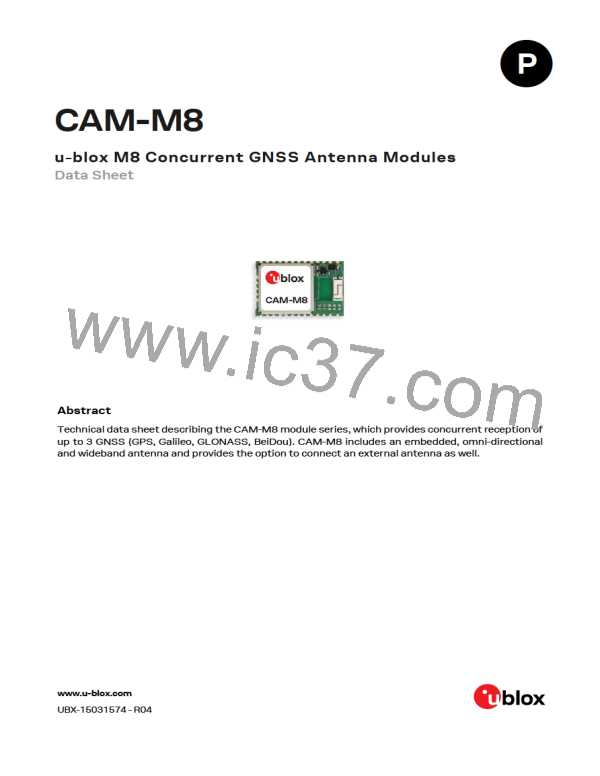CAM-M8 - Data Sheet
1.5.4 Galileo
The CAM-M8 series positioning modules can receive and track the E1-B/C signals centered on the
GPS L1 frequency band. GPS and Galileo signals can be processed concurrently together with either
BeiDou or GLONASS signals, enhancing coverage, reliability and accuracy. The SAR return link
message (RLM) parameters for both short and long versions are decoded by the receiver and made
available to users via UBX proprietary messages.
☞
Galileo has been implemented according to ICD release 1.2 (November 2015) and verified with
live signals from the Galileo in-orbit validation campaign. Since the Galileo satellite system has
not yet reached Initial (IOC) nor Full Operational Capability (FOC), changes to the Galileo signal
specification (OS SIS ICD) remain theoretically possible. u-blox therefore recommends to use
Flash based modules in designs utilizing Galileo signals in order to allow for a FW update in the
unlikely event of a change to the Galileo signal specification (OS SIS ICD).
☞
Galileo reception is by default disabled, but can be enabled by sending a configuration message
(UBX-CFG-GNSS) to the receiver. See the u-blox 8 / u-blox M8 Receiver Description Including
Protocol Specification [2] for more information.
1.6 Assisted GNSS (A-GNSS)
Supply of aiding information, such as ephemeris, almanac, rough last position and time, will reduce
the time to first fix significantly and improve the acquisition sensitivity. The u-blox CAM-M8 series
receivers support the u-blox AssistNow Online and AssistNow Offline A-GNSS services, support
AssistNow Autonomous, and are OMA SUPL compliant.
1.6.1 AssistNow™ Online
With AssistNow Online, an internet-connected GNSS device downloads assistance data from u-
blox’s AssistNow Online Service at system start-up. AssistNow Online is network operator
independent and globally available.
u-blox only sends ephemeris data for those satellites currently visible to the device requesting the
data, thus minimizing the amount of data transferred.
Supply of aiding information, such as ephemeris, almanac, rough last position and time, will reduce
the time to first fix significantly and improve the acquisition sensitivity.
☞
The AssistNow Online service provides data for GPS, GLONASS, BeiDou, Galileo and QZSS
1.6.2 AssistNow™ Offline
With AssistNow Offline, users download u-blox’s long-term orbit data from the Internet at their
convenience. The orbit data must be stored in the memory of application processor. Therefore, the
service requires no connectivity at system start-up and enables a position fix within seconds, even
when no network is available. AssistNow Offline data offers augmentation for up to 35 days.
☞
AssistNow Offline service provides data for GPS and GLONASS only, BeiDou and Galileo are not
currently supported
1.6.3 AssistNow™ Autonomous
AssistNow Autonomous provides aiding information without the need for a host or external network
connection. Based on previous broadcast satellite ephemeris data downloaded to and stored by the
UBX-15031574 - R04
Production Information
Page 9 of 31

 U-BLOX [ u-blox AG ]
U-BLOX [ u-blox AG ]